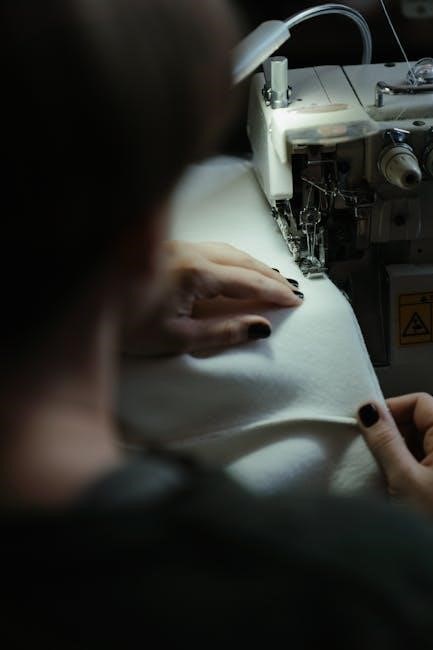
instruction manual for singer simple sewing machine
The Singer Simple sewing machine is a versatile, automatic sewing machine designed for both beginners and experienced sewists. It features a user-friendly interface, one-step buttonhole creation, and adjustable stitch settings, making it ideal for various sewing projects, from basic repairs to creative crafts.
Overview of the Singer Simple Sewing Machine
The Singer Simple sewing machine is a versatile and user-friendly appliance designed for both beginners and experienced sewists. It offers a range of features, including one-step buttonhole creation, a free arm for easy sewing of cuffs and sleeves, and adjustable stitch length and width. With 32 built-in stitch patterns, it supports various sewing projects, from basic repairs to decorative stitching. The machine is lightweight and portable, making it ideal for home use. Its automatic features simplify the sewing process, while its durable construction ensures long-lasting performance. The Singer Simple is a practical choice for anyone looking to explore creative sewing projects with ease and precision.
Importance of Following the Instruction Manual
Following the instruction manual for the Singer Simple sewing machine is essential for ensuring safe and effective operation. The manual provides detailed guidance on setup, threading, and troubleshooting, helping users avoid common mistakes that could damage the machine or lead to poor stitch quality. It also outlines safety precautions, such as keeping fingers away from moving parts and using the correct needle plate, to prevent accidents. By adhering to the manual, users can maximize the machine’s performance, extend its lifespan, and achieve professional-quality results. Proper use also enhances creativity and productivity, making the sewing experience enjoyable and rewarding for all skill levels.
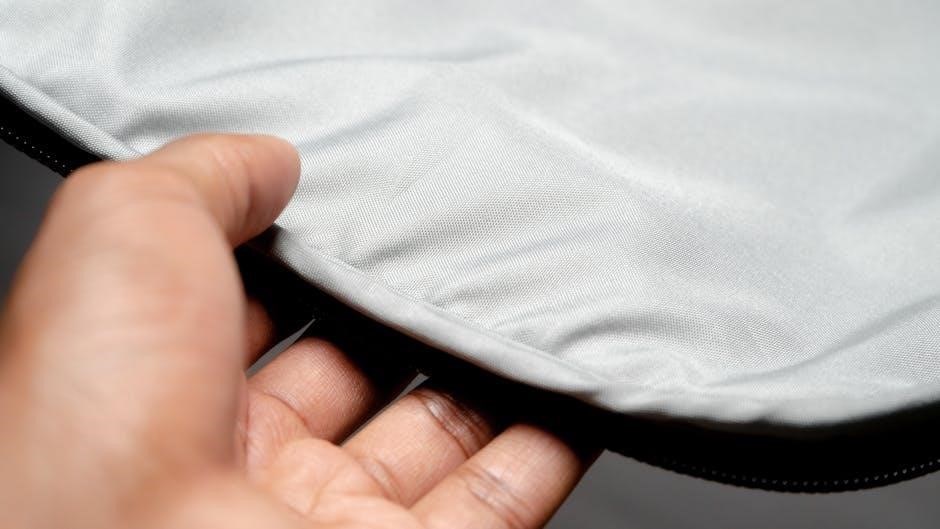
Safety Precautions and Basic Setup
Always follow safety guidelines, like keeping fingers away from moving parts and avoiding use near children. Proper setup ensures smooth operation and prevents potential damage or accidents.
General Safety Guidelines for Sewing Machines
To ensure safe operation of the Singer Simple sewing machine, always keep children away and avoid using the machine near water. Never wear loose clothing or jewelry that could get caught in moving parts. Keep fingers away from the needle and feed dogs, as they can cause injury. Avoid distractions while sewing and use the correct needle plate to prevent needle breakage. Do not overload electrical outlets or use damaged power cords. Regularly inspect and maintain the machine to ensure optimal performance and safety. Always follow the manufacturer’s guidelines for electrical safety and proper usage to prevent accidents and extend the machine’s lifespan.
Unpacking and Initial Inspection of the Machine
When unpacking your Singer Simple sewing machine, carefully remove it from the box and inspect for any visible damage. Ensure all accessories, such as needles, bobbins, and the power cord, are included. Check the machine’s exterior and interior for scratches or dents. Verify that the needle, presser foot, and feed dogs are properly aligned and undamaged. Before use, read the instruction manual to familiarize yourself with the machine’s components and features. This step ensures a smooth setup and helps you identify any potential issues early on, preventing future complications during operation.
Placing the Machine on a Stable Surface
Place the Singer Simple sewing machine on a sturdy, flat surface, such as a sewing table or desk, ensuring it is level and secure. Avoid uneven or wobbly surfaces, as they may cause vibration or inconsistent stitching. Position the machine in a well-lit area to enhance visibility while sewing; Keep it away from water, direct sunlight, or extreme temperatures to protect its electrical components. Ensure there is enough space around the machine for comfortable operation and fabric movement. A stable setup ensures smooth performance and helps maintain the machine’s longevity. Refer to the manual for specific placement recommendations to optimize your sewing experience.
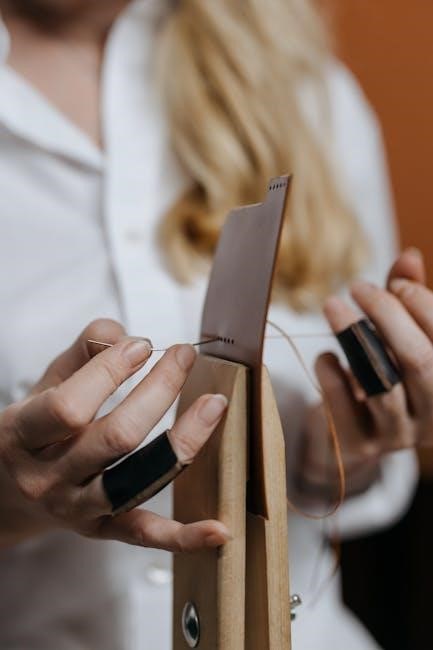
Understanding the Machine’s Features
The Singer Simple sewing machine offers a range of features, including 32 stitch patterns, a one-step buttonhole, free arm, and adjustable stitch length and width for versatility.
Stitch Patterns and Their Functions
The Singer Simple sewing machine comes with 32 built-in stitch patterns, offering versatility for various sewing tasks. These include straight stitches, zigzag stitches, and decorative patterns. Straight stitches are ideal for basic sewing and repairs, while zigzag stitches are perfect for preventing fraying on raw edges. Decorative stitches add a creative touch to projects, making them suitable for crafting and embroidery. Each stitch pattern serves a specific purpose, allowing users to customize their work according to their needs. This variety ensures that the machine can handle everything from simple mending to intricate designs, catering to both beginners and experienced sewists.
Buttonhole Creation: 1-Step Buttonhole Feature
The Singer Simple sewing machine features a convenient 1-Step Buttonhole function, designed to simplify the process of creating professional-looking buttonholes. This automatic feature allows users to sew perfect buttonholes in just one easy step, eliminating the need for manual adjustments or multiple steps. The machine guides the fabric smoothly, ensuring consistent results every time. This feature is particularly useful for sewing shirts, jackets, and other garments that require buttonholes. It saves time and effort, making it ideal for both beginners and experienced sewists who want to achieve precise, high-quality buttonholes effortlessly.
Free Arm and Its Uses
The Singer Simple sewing machine includes a free arm, a versatile feature that enhances sewing convenience. The free arm allows easy access to hard-to-reach areas, making it ideal for sewing cylindrical items like sleeves, pant legs, and collars. This feature is particularly useful for creating professional-looking hems and seams in tight spaces. By providing more control over fabric movement, the free arm simplifies tasks such as sewing curves or small projects. It also enables precise stitching when working with delicate or intricately shaped fabrics. This practical design makes the Singer Simple sewing machine a great tool for both beginners and experienced sewists, offering flexibility and ease in various sewing projects.
Adjusting Stitch Length and Width
The Singer Simple sewing machine allows for easy adjustment of stitch length and width to suit various fabrics and sewing needs. Using the convenient stitch length and width adjustment buttons, you can customize your stitches for precise results. The machine offers a range of stitch settings, from delicate to heavy-duty, ensuring versatility in your projects. Adjusting these settings is straightforward, with clear markings to guide you. Proper adjustment ensures even stitching, prevents fabric puckering, and enhances the overall quality of your seams. This feature is particularly useful for handling different materials, from lightweight cotton to thicker fabrics, making it a practical tool for diverse sewing tasks.
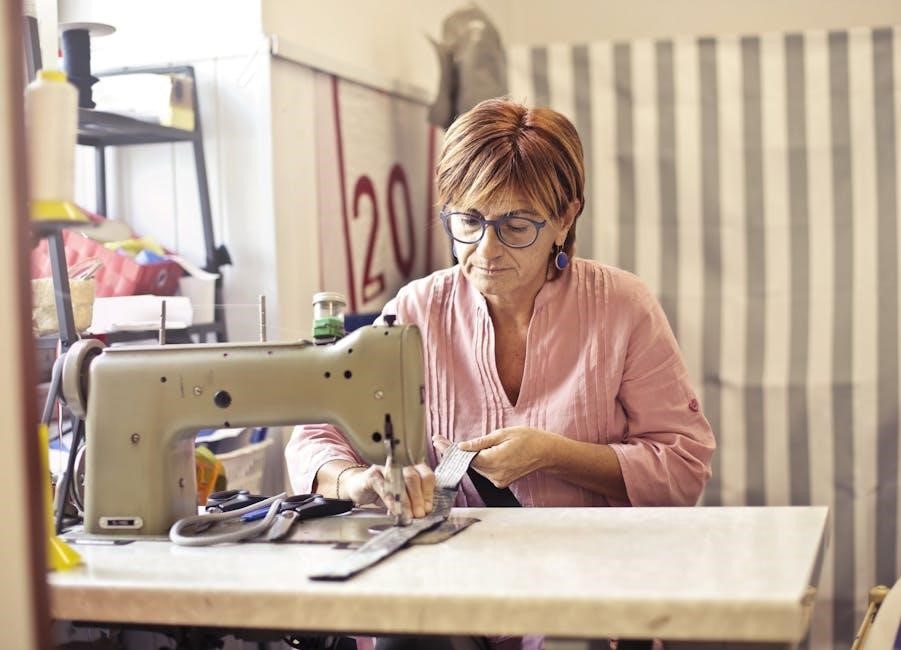
Threading the Machine
Threading the Singer Simple sewing machine involves carefully guiding the thread through the upper tension, take-up lever, and needle. Proper threading ensures smooth stitching and prevents tangles.
Threading the Upper Part of the Machine
Threading the upper part of the Singer Simple sewing machine begins by placing the spool on the spool pin and pulling the thread through the tension discs. Gently guide the thread through the take-up lever, ensuring it clicks into place. Next, insert the thread into the needle bar and carefully lower it to avoid tangling. Finally, pull the thread gently to ensure proper tension and trim any excess. Always refer to the manual for specific diagrams. Proper threading is essential for smooth stitching and prevents machine malfunction. Using the correct needle plate is also crucial to avoid needle breakage during operation. Follow these steps carefully for optimal results.
Threading the Bobbin and Inserting It
To thread the bobbin, start by placing the bobbin on the winder and securing the thread. Wind the thread smoothly around the bobbin, ensuring it is evenly filled. Once full, cut the excess thread. Next, locate the bobbin case and open it by pulling the latch. Insert the bobbin, making sure the thread unwinds counterclockwise. Gently pull the thread to set the tension and close the bobbin case. Ensure the bobbin is properly seated to avoid stitching issues. Always use the correct bobbin size as specified in the manual for optimal performance. Proper bobbin threading is essential for consistent stitch quality and machine operation.
Troubleshooting Common Threading Issues
If the thread does not move or the machine jams, check for proper threading. Ensure the spool is correctly placed and the thread guides are aligned. If the bobbin thread is visible on the fabric, the bobbin may not be seated properly. Remove the bobbin, clean the bobbin case, and reinsert it, ensuring it clicks into place. If the needle thread is loose, pull gently to tighten. Check for tangled thread near the spool or take-up lever. Ensure the needle is correctly inserted and the machine is properly oiled. If issues persist, consult the manual for specific troubleshooting steps or contact Singer support for assistance.
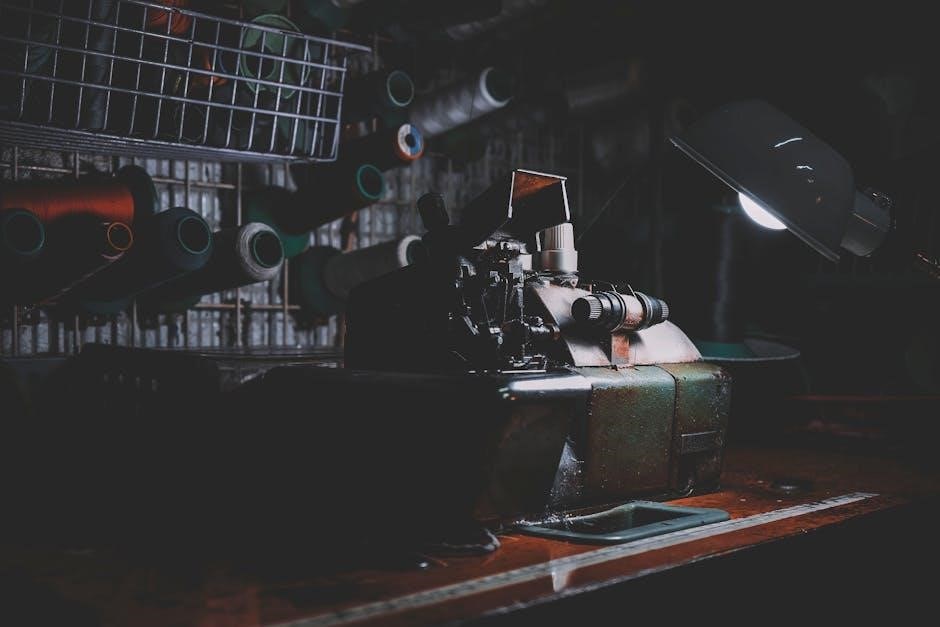
Basic Sewing Operations
Start by selecting fabric, then place it under the needle, aligning edges with the machine’s guide. Gently guide the fabric as it sews, ensuring even stitches. Use reverse stitching to secure seams, then cut the thread. Always follow the manual for specific settings and techniques tailored to your project.
Selecting the Right Fabric for Your Project
Selecting the appropriate fabric is crucial for achieving professional results with your Singer Simple sewing machine. Always consider the project’s purpose, durability, and desired texture. Cotton and linen are ideal for everyday sewing, while polyester blends offer wrinkle resistance. Silk and rayon are perfect for delicate or decorative projects. For heavier-duty tasks, denim or canvas is recommended. Ensure the fabric aligns with the machine’s stitch settings and thread type. Refer to the Singer Simple manual for fabric-specific stitch recommendations. Proper fabric selection ensures smooth operation, prevents damage, and enhances the final outcome of your sewing projects.
Setting Up the Fabric and Starting to Sew
Before sewing, ensure the fabric is properly aligned and pinned if necessary. Place the fabric under the machine’s needle, aligning the edge with the seam guide; Lower the presser foot gently to secure the fabric. Select the appropriate stitch pattern and tension settings based on the fabric type. Hold the fabric steady with both hands, keeping fingers away from the needle. Start sewing at a slow, steady pace, guiding the fabric smoothly under the needle. For straight lines, use the edge of the presser foot as a guide. Always backstitch at the beginning and end of seams for added security. This ensures a professional finish and prevents seam unraveling.
Reverse Stitching and Securing Seams
Reverse stitching is essential for securing seams and preventing them from unraveling. To reverse stitch, press the reverse stitch button located on the machine’s control panel. This will sew a few stitches backward, reinforcing the starting point. At the end of the seam, repeat the process to secure the finish. Always use a matching thread color for consistency. For thicker fabrics, consider increasing the stitch length slightly for added durability. Proper backstitching ensures professional-looking results and extends the lifespan of your sewing projects. Regularly check the machine’s tension to maintain even stitching quality. This step is crucial for both beginners and experienced users alike.
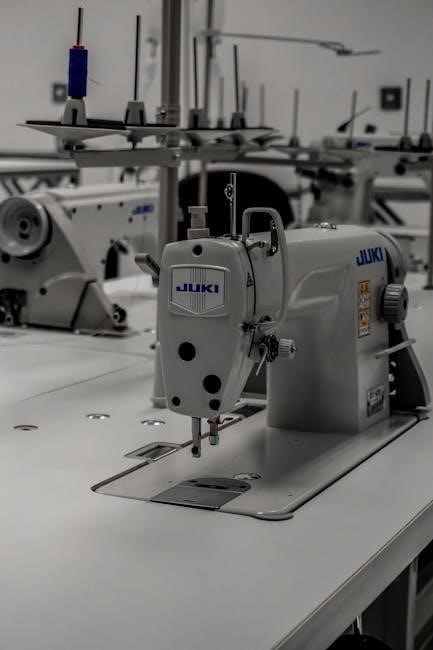
Advanced Features and Techniques
The Singer Simple sewing machine offers advanced features like adjustable stitch length and width, enabling precise control for intricate patterns and heavy-duty fabrics, enhancing creativity and efficiency.
Using the Variable Stitch Length and Width
The Singer Simple sewing machine allows users to adjust both stitch length and width, providing flexibility for various fabrics and sewing projects. The stitch length can be shortened for delicate materials or lengthened for heavier fabrics, ensuring secure seams. Similarly, the stitch width adjustment is ideal for zigzag stitching, accommodating different fabric types and decorative needs. By using the control buttons, sewists can customize settings to achieve professional results. This feature is particularly useful for intricate patterns and layered fabrics, enhancing creativity and precision in every stitch.
Creating Decorative Stitches and Patterns
The Singer Simple sewing machine offers 32 built-in stitch patterns, including decorative options for embellishing fabrics. Users can easily select various stitches to create intricate designs, such as floral motifs or geometric patterns. The one-step buttonhole feature also adds a professional touch to garments. By adjusting the stitch width and length, sewists can customize patterns for different fabrics and projects. This versatility makes the machine ideal for crafting decorative elements like borders, appliqué, and quilting designs. With its user-friendly interface, the Singer Simple empowers creators to explore their creativity and bring unique, personalized touches to their sewing projects effortlessly.
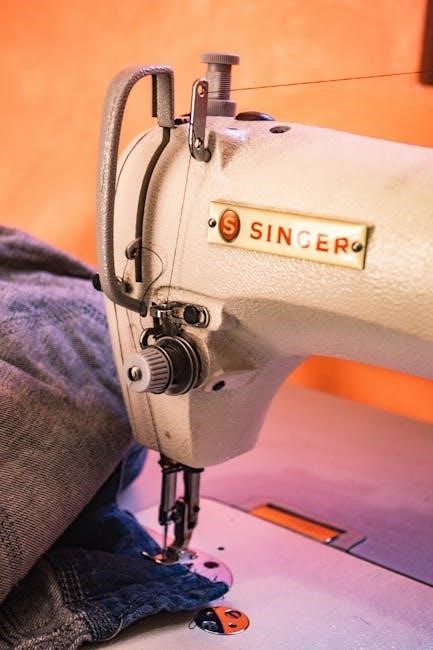
Maintenance and Care
Regularly clean the machine, oil moving parts, and check for dust buildup. Refer to the manual for specific cleaning and maintenance procedures to ensure optimal performance and longevity.
Cleaning the Machine and Feed Dogs
Cleaning the Singer Simple sewing machine is essential for maintaining its performance. Turn off and unplug the machine before starting. Use a soft brush or cloth to remove dust and debris from the exterior and internal components. The feed dogs should be cleaned gently to avoid damage. Remove the needle plate and thoroughly clean the area around the feed dogs using a small brush. Refer to the manual for specific instructions on accessing and cleaning these parts. Regular cleaning prevents lint buildup and ensures smooth fabric movement during sewing. Always ensure the machine is dry and free from lint before storing.
Oiling the Machine for Smooth Operation
Regular oiling is crucial for maintaining the Singer Simple sewing machine’s smooth operation. Turn off and unplug the machine before oiling. Locate the oil ports as indicated in the manual, typically near the bobbin area or hook race. Use high-quality sewing machine oil, applying a few drops to the specified points. Gently turn the handwheel to distribute the oil evenly. Avoid over-oiling, as excess oil can attract dust and lint. Refer to the manual for specific oiling intervals, usually after every 50 hours of use. Proper lubrication ensures that moving parts operate seamlessly, preventing wear and tear and maintaining optimal performance. Always wipe away excess oil with a clean cloth to keep the machine clean and functional.
Regular Maintenance Schedule
Regular maintenance ensures the Singer Simple sewing machine runs efficiently. Clean the machine after each use, removing lint and debris from the bobbin area, feed dogs, and stitch plate. Oil the machine every 50 hours of use, following the manual’s guidelines. Check the needle and bobbin for damage or wear, replacing them as needed. Dust the exterior with a soft cloth and avoid harsh chemicals. Every 12-18 months, have the machine professionally serviced to inspect internal components and ensure proper alignment. Adhering to this schedule prevents mechanical issues, maintains stitch quality, and extends the machine’s lifespan. Consistent care ensures reliable performance for all your sewing projects.
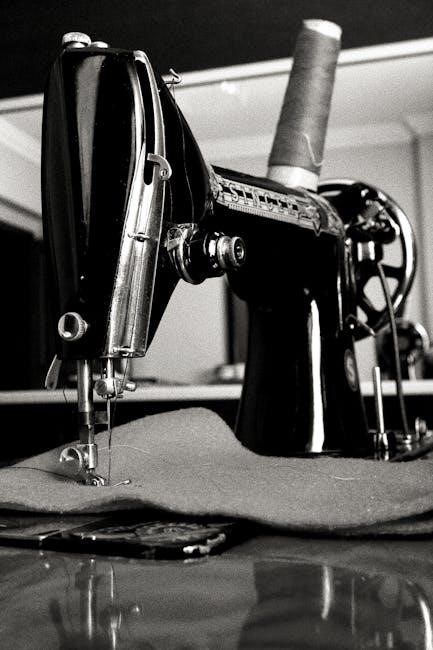
Troubleshooting Common Issues
Common issues include the machine not turning on, uneven stitches, or thread breakage. Consult the manual for solutions, such as checking power, adjusting tension, or cleaning the machine.
Machine Not Turning On or Malfunctioning
If the Singer Simple sewing machine fails to turn on, check the power cord and ensure it’s properly plugged in. Verify that the outlet is functioning by testing it with another appliance. If the machine is plugged in but still doesn’t power on, inspect the power switch for damage or wear. Consult the manual for guidance on resetting or replacing faulty components. Regular maintenance, such as cleaning and oiling, can prevent malfunctions. Always refer to the troubleshooting section of the manual for specific solutions to restore your machine’s operation efficiently.
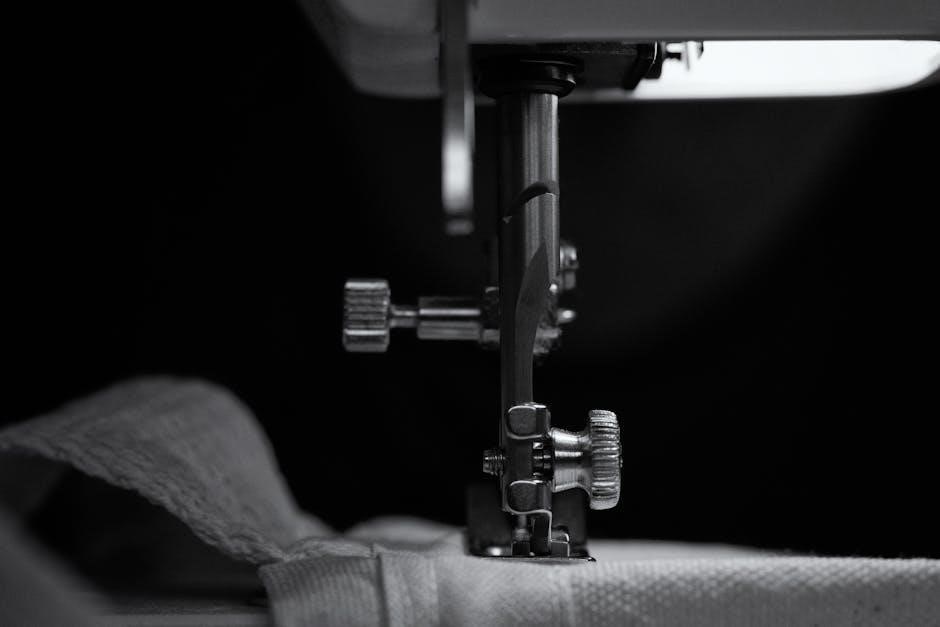
Issues with Stitch Quality or Tension
If your Singer Simple sewing machine produces uneven stitches or inconsistent tension, check the thread setup and ensure proper threading. Verify that the bobbin is correctly inserted and that thread tension is balanced. Incorrect needle size or type can also affect stitch quality, so use the appropriate needle for your fabric. Regularly clean the machine to remove lint and debris, which can disrupt tension. Adjust the stitch length and width settings as needed for your fabric type. If issues persist, refer to the manual’s troubleshooting guide for specific solutions to restore optimal stitch quality and tension for seamless sewing results.
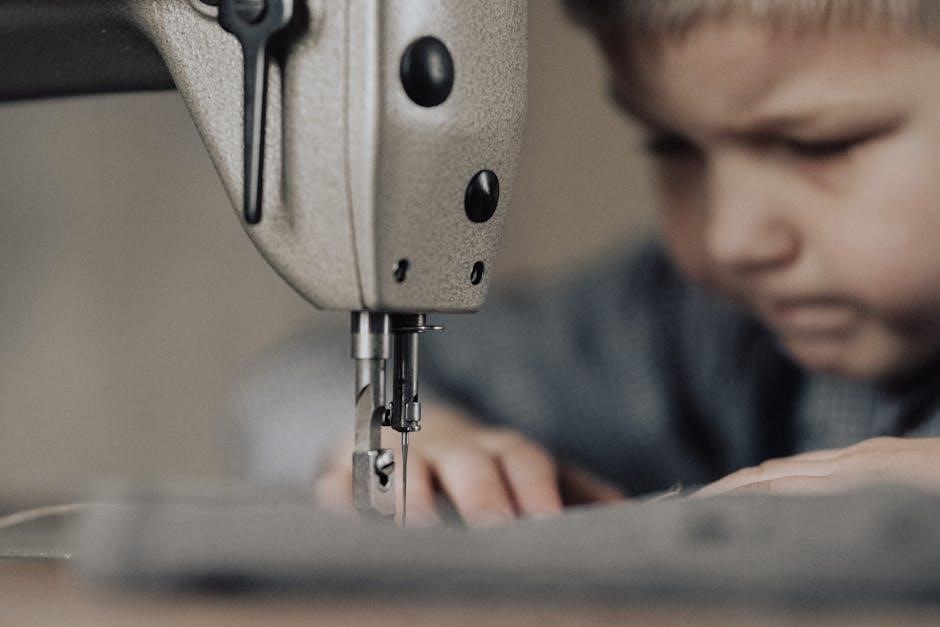
Model-Specific Instructions
Model-specific instructions provide tailored guidelines and unique features for each Singer Simple sewing machine, ensuring optimal performance for various sewing projects and user needs.
Guidelines for Singer Simple 2263 Model
The Singer Simple 2263 model offers robust performance with a heavy-duty design, ideal for sewing thick fabrics like denim and canvas. It features a powerful motor, 32 stitch patterns, and a one-step buttonhole function for convenience. The manual provides detailed instructions for setup, maintenance, and troubleshooting. Users are advised to follow safety guidelines, such as keeping fingers away from moving parts and using the proper needle plate. Regular oiling and cleaning are recommended to ensure smooth operation. The 2263 model is perfect for both beginners and experienced sewists, offering versatility and reliability for a wide range of sewing projects.
Specific Features of the Singer Simple 3223
The Singer Simple 3223 model is designed for versatility and ease of use, featuring 32 built-in stitch patterns, including basic, decorative, and stretch stitches. It includes a one-step buttonhole function for quick and precise buttonhole creation. The machine also offers adjustable stitch length and width, allowing for customization based on fabric type and project needs. A free arm is included for easy sewing of cuffs, sleeves, and other hard-to-reach areas. The Singer Simple 3223 is equipped with a heavy-duty motor, making it suitable for sewing through thick fabrics. This model is ideal for both beginners and experienced sewists, providing reliable performance for a wide range of sewing tasks.
Operating the Singer Simple 3337 Model
The Singer Simple 3337 model is designed for ease of use, featuring 32 stitch patterns, including basic, decorative, and stretch stitches. It includes a one-step buttonhole function for quick creation of buttonholes. The free arm allows for easy sewing of hard-to-reach areas like sleeves and cuffs. Adjusting stitch length and width is straightforward, enabling customization for various fabrics. The machine also features automatic needle threading and tension control for consistent stitching. With a heavy-duty motor, it handles thick fabrics effortlessly. Designed for both beginners and experienced sewists, the Singer Simple 3337 provides reliable performance for a wide range of sewing projects, ensuring precision and creativity.
The Singer Simple sewing machine is a user-friendly, versatile tool for both beginners and experienced sewists. It combines simplicity with creativity, making sewing enjoyable and practical.
Final Tips for Effective Use of the Singer Simple
Regularly oil the machine to ensure smooth operation and extend its lifespan. Always refer to the manual for specific maintenance instructions. Keep the machine clean, especially the feed dogs and bobbin area, to prevent fabric jams. Experiment with different stitch patterns and fabrics to explore your creativity. Store the machine in a dry, cool place to avoid rust or damage. By following these tips, you can maximize the performance of your Singer Simple sewing machine and enjoy a seamless sewing experience for years to come.
Encouragement to Explore Creative Sewing Projects
With the Singer Simple sewing machine, unlock your creativity and explore a wide range of sewing projects! From crafting home decor to designing custom clothing, the machine’s versatility makes it perfect for both beginners and skilled sewists. Experiment with the 32 built-in stitch patterns, create decorative designs, and take advantage of the one-step buttonhole feature for professional finishes. Whether you’re making gifts, repairing garments, or creating unique textiles, the Singer Simple empowers you to bring your ideas to life. Embrace the joy of sewing and let your imagination guide you in creating something truly special with every stitch!